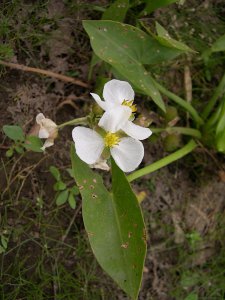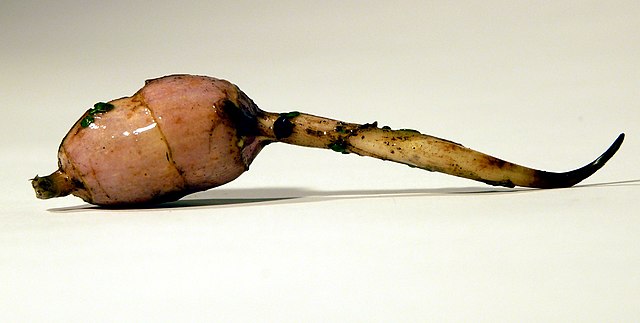Arum-leaved arrowhead (Sagittaria cuneata) is a wild edible plant that is common in wetland areas in the Pacific Northwest, most of the West, and the Northeastern United States. Arum-leaved arrowhead plants are naturally found in marshes, swamps, wet prairies, streambanks, and along the edges of ponds.

Arum-leaved arrowhead is native mostly to the Midwest, however, it’s native to many parts of the US in states where it’s found naturally.
Also known as “Indian potato” or “duck potato”, the arum-leaved arrowhead was one of the staples that kept the Lewis and Clark expedition fed during the winter of latter 1805 and early 1806. This tuber was harvested by Native Americans by using sticks and their feet to agitate the muddy soil they grow in. The arrowhead tubers would float to the top of the water where they are easily collected.
Arum-leaved Arrowhead Edibility and Culinary Use
Arum-leaved arrowhead is a tuber that has a texture similar to potatoes, however, when it is roasted or boiled, they have a taste similar to water chestnuts.
The Native North Americans ate them raw, boiled, fried, dried, baked, roasted, mashed, ground into flour, or candied with maple sugar. The Cheyenne were known to collect the stems below the flowers, peel the skin off, and eat them raw.

When gathering arum-leaved arrowhead, first start by locating the plant by its white petal and yellow-centered flowers, and its arrowhead-shaped leaves. Take your hands or your feet and follow the stem down to the potato-like root in the muddy soil. Once you’ve located the root, simply pull them out and they should float to the top.
Scrub the dirt off the arrowhead tubers and boil them in salt water for 15 minutes. You can eat them raw, however, they are easier to eat after you peel them.

The young shoots of the arum-leaved arrowhead can be cooked like spinach, but with a sweet corn-like flavor, similar to the tubers.
Arum-leaved arrowheads can be used as a potato substitute in many recipes. Let’s look at a classic staple at the American dinner table; creamed potatoes. In this recipe, you start by slicing your arrowhead tubers and boiling them while covered for 20-30 minutes until tender. Next, you place a saucepan over medium heat to melt butter then you sautee onions, carrots, and celery for about 10 minutes. Once the vegetables are tender, add them along with sour cream and seasoning to the cooked tubers, mix well and serve.
Like potatoes, you can also make a “junk food” familiar to the Pacific Northwest; the potato chip. It’s recommended that if you decide to make potato chips, you will be better off using broadleaf arrowhead (Sagittaria latifolia) since the tubers are typically larger and will make for better chips.
You can also pulverize the arum-leaved arrowhead into a gluten-free flour to make bread or substitute for wheat flour in other recipes.
Arum-leaved Arrowhead Health Benefit
Arum-leaved arrowhead root tuber is very healthy for you. Arrowhead plants are low in fat, high in dietary fiber, and rich in essential minerals such as iron, manganese, calcium, potassium, copper, zinc, and magnesium.
The arum-leaved arrowhead tubers are an excellent source of vitamins A, B1 (thiamine), B2 (riboflavin), and B3 (niacin), and Vitamin C. They also contain high phytochemical and antioxidant properties, which help fight cancer and heart disease, as well as boost the immune system.
Arum-leaved arrowheads were used as an herbal remedy by many Native American tribes to treat various ailments such as dysentery, diarrhea, boils, urinary tract infections, and as a sedative.
In addition, arrowhead roots have been used as a laxative to treat abdominal pain, gas, and bloating due to the high levels of fiber found in the tubers. It has also been used traditionally by Native American tribes to treat menstrual cramps.
Arumleaved Arrowhead Cautions
Arum-leaved arrowhead has been used for thousands of years as a food source, and it is still used today by many people who enjoy this wild edible plant. However, before you harvest arum-leaved arrowhead, make sure you know how to correctly identify it. This plant resembles a lot of other arrowhead plant species, so it’s important that you know what you’re looking for.
The poisonous arrow arum (Peltandra virginica) looks very similar to the arum-leaved arrowhead, except for the veins on the leaves. If the leaves have 3 veins on them, stay away, if they have many veins on the leaves, then you have arum-leaved arrowhead and it’s safe to eat.
Steer clear of foraging in waters that are potentially polluted. The majority of the plant is submerged in water, and if the water is polluted with toxins, industrial waste, or heavy metals, you will be consuming those as well.
Conclusion
Arum-leaved arrowhead is the wild potato that can be the healthy potato replacement you can find during foraging. It has similar uses to potatoes but with an added sweet, corn-like flavor, making it perfect in mashed or roasted dishes. It’s also versatile as a gluten-free bread option and as one of our favorite junk foods, potato chips. This will sure to be a crowd-pleaser at your next foraged meal!







One Response
When will the next class be held?